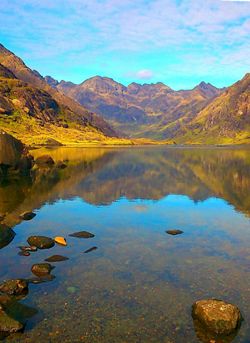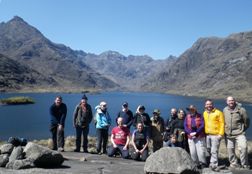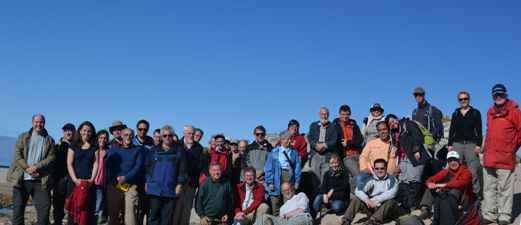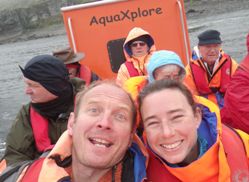GSA in the Highlands and Islands
Dougal Jerram, Kathryn Goodenough and Rob Butler report on the Geol Soc fieldtrips to Skye/Rum and the Northwest Highlands put on as part of the GSA 125th year celebrations.
 The Geological Society has had close ties with its counterpart over the pond, the Geological Society of America. When it came to the GSA reaching the milestone of 125 years old, the Society helped with the celebrations by organising two field trips to seminal locations in Scotland that played key roles in the development of our understanding of geology. Two trips were run in May and June of 2013: the first, led by Dougal Jerram, Kathryn Goodenough and Simon Drake, visited the islands of Skye and Rum. The second trip, led by Rob Butler and Rick Law was to the Northwest Highlands.
The Geological Society has had close ties with its counterpart over the pond, the Geological Society of America. When it came to the GSA reaching the milestone of 125 years old, the Society helped with the celebrations by organising two field trips to seminal locations in Scotland that played key roles in the development of our understanding of geology. Two trips were run in May and June of 2013: the first, led by Dougal Jerram, Kathryn Goodenough and Simon Drake, visited the islands of Skye and Rum. The second trip, led by Rob Butler and Rick Law was to the Northwest Highlands.
TRIP1: The Great British Tertiary Volcanoes: Exploring the Palaeogene centres of Skye and Rum;
The igneous centres of the western Highlands and Islands of Scotland have provided the starting point for much of our understanding of petrology. Classic studies like those of Harker (Skye) and Emeleus (Rum) have unravelled the inner workings of volcanic plumbing systems and their products. The first GSA-Geol Soc trip was based on the Isle of Skye, exploring two of these great igneous centres. The group travelled by foot and boat to look at layered igneous rocks, sills/dykes, lava flows and explosive volcanism, amongst the backdrop and beauty of the inner Isles of Skye and Rum. Highlights of the trip included a boat and walking trip to Loch Coruisk in the igneous centre of Skye, and a high speed day boat trip to explore the Isle of Rum.
TRIP 2: Structure and tectonics of the NW Highlands of Scotland: from deep crust to hydrocarbon reservoirs
 The NW Highlands of Scotland is classic ground for structural geology. It was here that many of the key concepts were developed, from the recognition and analysis of thrust systems to the discovery of mylonites. The region remains an important test-bed for modern ideas in structure and tectonics, a training ground for the next generation of earth scientists and a home to analogues for faults in offshore oilfields. The 34 participants, aided by some Spring-time dry weather, got to experience a broad range of faults and shear zones within the tectonic context of NW Britain. These structures chart deformation styles in the deep crust through various forms of mylonites and cataclasites right up to faulting and damage in analogue hydrocarbon reservoirs.
The NW Highlands of Scotland is classic ground for structural geology. It was here that many of the key concepts were developed, from the recognition and analysis of thrust systems to the discovery of mylonites. The region remains an important test-bed for modern ideas in structure and tectonics, a training ground for the next generation of earth scientists and a home to analogues for faults in offshore oilfields. The 34 participants, aided by some Spring-time dry weather, got to experience a broad range of faults and shear zones within the tectonic context of NW Britain. These structures chart deformation styles in the deep crust through various forms of mylonites and cataclasites right up to faulting and damage in analogue hydrocarbon reservoirs.
Starting on classic high grade deformation in the Lewisian on the NW coast, the key component of the trip was a geotraverse from the NW Highlands Geopark along the north Sutherland coast, finishing off with a look at Jurassic faults on the flanks of the Moray Firth basin. A report on this trip by then GSA President (and trip participant) George Davis appeared in the October 2013 issue of GSA Today.
THANK YOU!
 We would like thank the Geological Society and the GSA for help in setting up the trips, and thanks to Rick Law and Simon Drake for help with leadership, logistics and field trip running. Birkbeck University are thanked for provision of their minibus, and Simon Drake is particularly thanked for his driving of the minibus on the Skye/Rum trip. The Volcanic & Magmatic Studies Group pledged financial support towards the Skye/Rum trip which was particularly helpful in keeping costs down.
We would like thank the Geological Society and the GSA for help in setting up the trips, and thanks to Rick Law and Simon Drake for help with leadership, logistics and field trip running. Birkbeck University are thanked for provision of their minibus, and Simon Drake is particularly thanked for his driving of the minibus on the Skye/Rum trip. The Volcanic & Magmatic Studies Group pledged financial support towards the Skye/Rum trip which was particularly helpful in keeping costs down.
Authors
